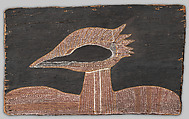Bark Painting
Not on view
Bark painting in Arnhem Land is one of the most dynamic contemporary art movements in Australia. Artists paint their stories on lengths of fibrous bark harvested from the trunks of eucalyptus trees. Groote Eylandt, in Anindilyakwa Country off the coast of northeast Arnhem Land, has been a center of bark painting since the 1920s. The heavy black background and dashed lines of red, white and yellow ochers that comprise this painting are characteristic of Anindilyakwa bark paintings from the middle of the twentieth century. The black pigment comes from the manganese that has been mined on Groote Eylandt for decades. Following the Second World War, some artists began extracting black pigment from the carbon in batteries that had been left on the island by Australian and American soldiers.
The design of this painting is enigmatic. A label attached to the back of the bark titles the piece, Chasm Island and Big Shell. The image also resembles the head and shoulders of an anthropomorphic bird-like figure. Chasm Island, off the northern coast of Groote Eylandt is known as the site of the first European documentation of Aboriginal rock art, one of the oldest continuously practiced artistic traditions in the world. It is likely that this painting refers to the mapping of this Country, or to ancestral stories relating to this area that link the landscape to early narratives of creation and the formation of geographical features.The painting was originally sold through the Church Missionary Society. The Groote Eylandt Mission was established at Emerald River in 1921. Its history is closely tied to the growth of the contemporary bark painting movement on the island. The first missionaries encouraged artists to produce portable barks that could be sold to provide income for the Mission. Artists began transferring the painted designs that previously decorated human bodies, rock shelters and the inner walls of bark huts onto bark panels. Designs associated with secret or sacred knowledge remained restricted to certain artists and ceremonies. By the middle of the twentieth century, when the current work was produced, Anindilyakwa paintings were becoming internationally recognized and represented in galleries and private collections.#1712. Bark Painting
Due to rights restrictions, this image cannot be enlarged, viewed at full screen, or downloaded.


